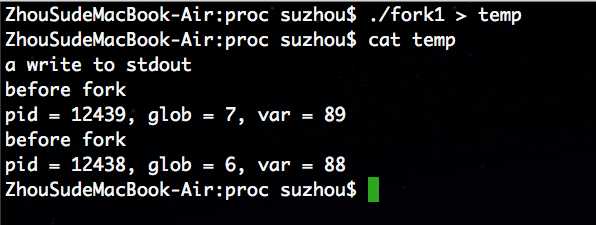标签:
本章包含内容有:
?
每个进程都有一个唯一的标识符,进程ID(process ID)。
进程的ID是可重用的,如果一个进程被终止,那么它的进程ID会被系统回收,但是会延迟使用,防止该进程ID标识的新进程被误认为是以前的进程。
三个特殊ID的进程:
获取进程各种ID的相关函数:
函数声明:
#include <unistd.h>
pid_t getpid(void); ? ? // Returns: process ID of calling process
pid_t getppid(void); ? ? ? ?// Returns: parent process ID of calling process
uid_t getuid(void); ? ? ? ?// Returns: real user ID of calling process
uid_t geteuid(void); ? ? ? // Returns: effective user ID of calling process
gid_t getgid(void); ? ? ? ?// Returns: real group ID of calling process
gid_t getegid(void); ? ? ? ?// Returns: effective group ID of calling process
这里的各种ID在前面第三篇中有说明,http://www.cnblogs.com/suzhou/p/4295535.html
?
fork函数用于一个已存在的进程创建一个新的进程。
函数声明:
#include <unistd.h>
pid_t fork(void);
函数细节:
Example:
#include "apue.h"
?
int ? ? globvar = 6;? ? ? ? /* external variable in initialized data */
char? ? buf[] = "a write to stdout\n";
?
int
main(void)
{
? ? int ? ? var;? ? ? ? /* automatic variable on the stack */
? ? pid_t ? pid;
?
? ? var = 88;
? ? if (write(STDOUT_FILENO, buf, sizeof(buf)-1) != sizeof(buf)-1)
? ? ? ? err_sys("write error");
? ? printf("before fork\n");? ? /* we don‘t flush stdout */
?
? ? if ((pid = fork()) < 0) {
? ? ? ? err_sys("fork error");
? ? } else if (pid == 0) {? ? ? /* child */
? ? ? ? globvar++;? ? ? ? ? ? ? /* modify variables */
? ? ? ? var++;
? ? } else {
? ? ? ? sleep(2); ? ? ? ? ? ? ? /* parent */
? ? }
?
? ? printf("pid = %ld, glob = %d, var = %d\n", (long)getpid(), globvar,
? ? ? var);
? ? exit(0);
}
执行结果:

pid为12291的进程为子进程,对变量glob和var进行了加1。
当把输出重定向到一个文件时,我们发现结果和直接输出到终端中不太一样:

原因:?
?
当调用fork函数时,父进程的所有打开的文件描述符都会复制一份到子进程中,包括文件偏移量(file offset)。
所以当父子进程同时写文件时,他们的操作都会更新同一个文件偏移量(file offset),加入子进程向文件中写入了一部分数据,同时更新了file offset,那么父进程进行写入操作时,会使用跟新以后的offset,从而避免了覆盖了子进程写入的数据。
父子进程共享文件如下图所示:

我们可以发现,父子进程拥有相同的文件描述符,又没有其他的同步方式,所以他们的输出可能会混起来(intermixed)。
fork之后,常见的处理父子进程拥有的文件描述符有两种方式:
除了打开的文件描述,其他的子进程会继承自父进程的内容包括:

父子进程不同的地方包括:
?
vfork和fork有相同的返回值。
vfork和fork的不同点:
?Example:
#include "apue.h"
?
int ? ? globvar = 6;? ? ? ? /* external variable in initialized data */
?
int
main(void)
{
? ? int ? ? var;? ? ? ? /* automatic variable on the stack */
? ? pid_t ? pid;
?
? ? var = 88;
? ? printf("before vfork\n"); ? /* we don‘t flush stdio */
? ? if ((pid = vfork()) < 0) {
? ? ? ? err_sys("vfork error");
? ? } else if (pid == 0) {? ? ? /* child */
? ? ? ? globvar++;? ? ? ? ? ? ? /* modify parent‘s variables */
? ? ? ? var++;
? ? ? ? _exit(0); ? ? ? ? ? ? ? /* child terminates */
? ? }
?
? ? /* parent continues here */
? ? printf("pid = %ld, glob = %d, var = %d\n", (long)getpid(), globvar,
? ? ? var);
?
? ? exit(0);
}
运行结果:

?
正常退出:三个函数exit,?
如果子进程不正常退出,则内核保证记录该进程的异常退出状态,该进程的父进程可以通过调用wait或者waitpid函数获取该子进程的异常退出状态。
如果父进程在子进程之前终止,则init进程成为该子进程的父进程。从而保证每个进程都有父进程。
如果子进程先终止(异常终止或者正常退出),内核会保存该子进程的部分信息,包括进程pid,进程终止时的状态和该进程占用的CPU时间,同时内核会清除该进程占用的内存,关闭所有已经打开的文件描述符。父进程可以通过检查该信息获取子进程的终止情况。
如果子进程先终止,而没有父进程调用waitpid获取该子进程的信息,那么这种进程被成为僵尸进程。使用ps命令可以看到僵尸进程的相关信息。
如果父进程为init进程,那么子进程异常终止并不会成为僵尸进程,因为init进程会对它的所有子进程调用wait函数获取子进程的终止状态。
?
子进程终止,内核会向父进程发送SIGCHLD信号。父进程默认的行为是忽略该信号,父进程也可以设置一个信号处理函数,当捕捉到该信号时,调用该处理函数,在后面的相关章节会介绍信号相关的概念。
本节介绍的wait和waitpid函数的作用是:
需要注意的一点是,如果我们在接收到SIGCHLD信号后,调用wait函数,则该函数会立刻返回。在其他情况下调用wait函数,则会阻塞。
函数声明:
#include <sys/wait.h>
pid_t wait(int *statloc);
pid_t waitpid(pid_t pid, int *statloc, int options);?
// Both return: process ID if OK, 0,or -1 on error
两个函数之间的区别:
函数细节:
返回值检查:
使用四个宏来检查wait和waitpid函数来获取子进程的终止状态(terminated status),如退出状态,信号值等信息。
四个宏的具体说明见下表所示:

pid的取值对waitpid函数行为的影响:
参数option的取值:

waitpid函数提供了三个wait没有的特性:
?
#include "apue.h"
#include <sys/wait.h>
?
int
main(void)
{
? ? pid_t ? pid;
?
? ? if ((pid = fork()) < 0) {
? ? ? ? err_sys("fork error");
? ? } else if (pid == 0) {? ? ? /* first child */
? ? ? ? if ((pid = fork()) < 0)
? ? ? ? ? ? err_sys("fork error");
? ? ? ? else if (pid > 0)
? ? ? ? {
? ? ? ? ? ? exit(0);? ? /* parent from second fork == first child */
? ? ? ? }
?
? ? ? ? /*
?? ? ? ? * We‘re the second child; our parent becomes init as soon
?? ? ? ? * as our real parent calls exit() in the statement above.
?? ? ? ? * Here‘s where we‘d continue executing, knowing that when
?? ? ? ? * we‘re done, init will reap our status.
? ? ? ? ?*/
? ? ? ? sleep(2);
? ? ? ? printf("second child, parent pid = %ld\n", (long)getppid());
? ? ? ? exit(0);
? ? }
?
? ? if (waitpid(pid, NULL, 0) != pid) ? /* wait for first child */
? ? ? ? err_sys("waitpid error");
?
? ? /*
?? ? * We‘re the parent (the original process); we continue executing,
?? ? * knowing that we‘re not the parent of the second child.
?? ? */
? ? exit(0);
}
执行结果:

结果分析:
在这里我们fork了两次,原因是,当我们想fork一个子进程出来,而我们不希望父进程阻塞在wait函数,并且不希望由于父进程没有调用wait函数先退出导致子进程成为僵尸进程,那么fork两次,并且退出第一个子进程,可以使得父进程及时退出,并且第二个子进程的父进程变成init进程。
?
本篇主要介绍了fork、vfork、僵尸进程、wait和waitpid函数,这些在unix环境中都是很重要的概念和函数,并且在面试中也经常问到。
下一篇的内容包括:
?
参考资料:
《Advanced Programming in the UNIX Envinronment 3rd》
?
UNIX高级环境编程(9)进程控制(Process Control)- fork,vfork,僵尸进程,wait和waitpid
标签:
原文地址:http://www.cnblogs.com/suzhou/p/4348978.html